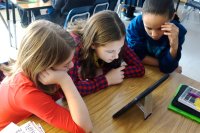Using Digital Tools to Promote Social and Emotional Learning
Educators can take advantage of digital tools that students want to use to enhance social and emotional learning efforts.
Your content has been saved!
Go to My Saved Content.As a researcher on digital learning, I was intrigued by the release of a new guide called Reclaiming Digital Futures, which is an effort to help community-based organizations integrate digital learning into their programs. My interest was piqued because the researchers behind this guide had unearthed ways that digital learning can support the fostering of social and emotional learning (SEL) skills.
I contacted one of those researchers, Rafi Santo, to learn more. The organizations that the researchers worked with combine “foundational approaches to youth development that have various SEL outcomes at their core with powerful work around digital tools and practices,” Santo said. The organizations imbued learning with real-world applications of SEL—the young people were engaged in relationship-building, responsible decision-making, and self-management.
Although the researchers studied out-of-school programs—also known as informal learning spaces—many of the findings can be applied to K–12 schooling.
Youth Voice and Power
The researchers unearthed several themes in the course of their work, including the importance of youth voice and power, or student voice, choice, and agency. “This was because many of the organizations in the cohort had a strong orientation towards having young people be part of the process of shaping what programmatic practice and pedagogy looks like,” Santo explained.
At YOUmedia, a program at the Chicago Public Library, codesign of programming happens in an organic way. “Educators developed rich relationships with kids in this space,” Santo said. “This included hanging out and messing around.” An example that’s included in the toolkit centers on youth who played Super Smash Bros., a fighting game from Nintendo. This interested me because esports programs (electronic sports leagues) have been growing in popularity outside of schools, and increasingly in schools.
There was just one problem: “Kids were playing together, but the game tended to foster controversy and competition—not the best SEL we were looking for, as it brings out conflict,” Santo said. The solution was to work with the most excited teens to create a Super Smash Bros. tournament that channeled that fun and competitive spirit into a more structured opportunity that pushed participants to collaborate, a component of SEL. They were empowered with tasks outside the game such as youth outreach and recruitment, project planning, timeline planning, and tournament facilitation.
This approach reminded me of conversations I’ve had with New Jersey-based educator Chris Aviles, who launched an esports program at his middle school. He runs his program as a team, not a club: Students need to maintain a certain GPA and can get cut from the squad.
What makes esports seem promising to Aviles and many other K–12 educators is that many participants may have no other home-school connection. Some of Aviles’s students play competitively, while others maintain the website, run social media accounts, record game videos, or shout-cast during livestreams (i.e., they do the play-by-play coverage). This approach is similar to the ways in which traditional team-based sports can guide young people to build character.
Embedding SEL in PBL
Another theme shared in the Reclaiming Digital Futures toolkit pertains to adult-youth collaboration on big digital maker projects, a theme developed in a set of case studies that reflect tenets of good project-based learning (PBL).
One case study of note is from the award-winning after-school educational program AS220 Youth, which runs a huge project each year called FutureWorlds. Many of the young people served by AS220 Youth are in the care and custody of the state. The organization is composed of interest-driven studios based on music, fashion, digital arts, visual arts, and video production. “You can be a youth in any of these studios and then become an apprentice,” Santo explained. “Apprentices then collaboratively come together at the beginning of the year and talk about what they would want future worlds to look like.”
In the case study shared in the toolkit, the AS220 Youth members use concepts from Afrofuturism, “a framework which is very rooted in both social justice and youth interest in sci-fi and speculative fiction, as well as a very positive orientation around speculating about possible futures rather than purely looking backwards,” Santo said. Wakanda, the high-tech society in Marvel’s Black Panther film and comics, is an example of Afrofuturism.
Each year, the kids in AS220 Youth choose a theme, and each studio plays a different role in developing that theme. “One year they made a massive haunted house where the theme was incarceration,” Santo said. “The apparel studio made all of the costumes, and the maker studio built the sets, and the music studio created the soundtracks.”
This case study connects SEL to youth leadership in a way that is “rooted in core issues relevant to youth,” Santo said. “Empathy is put into the context of community-based issues, which is really at the heart of what marginalized young people think about, and care about. On the other side, it speaks to the digital production interest youth have. It also provides an advocacy stance that they may not have ordinarily been able to have.”
The adult-youth collaboration approach can be adopted in K–12 schools using project resources provided by PBLWorks. Different grade levels, content areas, or entire schools can come together to address a community-based theme. For example, the K–2 social studies project Make a Difference begins with the driving question, “How can we take action to make a change in our community?” and culminates with a community service event.
The examples shared in the Reclaiming Digital Futures guide illustrate just how well SEL can be embedded in digital learning experiences. Educators need not carve out class time to explicitly teach empathy or collaboration; instead, opportunities should exist for students to practice those competencies in authentic and meaningful ways.
